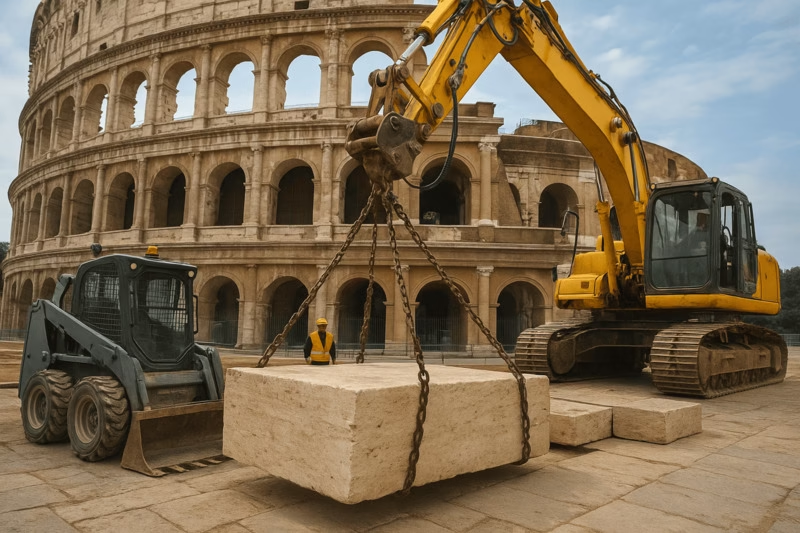Your cart is currently empty!

How Much Would It Cost to Rebuild the Colosseum Today?
And what its cost tells us about Rome and memory
Imagine walking through the Roman Forum. You come upon a new Colosseum, not a ruin, but a living, roaring amphitheater, fully rebuilt. What would it cost, in today’s world, to raise it again, block by block, arch by arch?
According to a recent estimate from Geopop, rebuilding the Colosseum today might cost around €190 million. Geopop That number stops us. It’s not just a dry statistic, it’s a lens on ambition, heritage, and scale.
Breaking down the €190 million figure
Geopop’s estimate dissects the cost into segments that are remarkably modern:
- Material & foundational work: Huge shares go to travertine, tuff, and concrete for the skeleton and base, over €105 million is allocated for the raw stone parts alone.
- Metal connectors: The iron clamps, brackets, and structural supports that once tied blocks together would cost €2.5 million.
- Wood & coverings: The wooden framework, the canvas awnings (velarium) to shade spectators, about €1 million in today’s build.
- Excavations & earthworks: Digging and preparing the foundation would itself cost around €14 million.
- Design, compliance, safety: Modern-day permits, engineering, code, and safety regulations account for a hefty €70 million.
Geopop rightly cautions that this is an indicative figure. real costs would shift depending on labor, site access, earthquake safeguards, and many unpredictable variables. Geopop
Why this “what if” matters to us
1. The scale of Roman ambition
When Vespasian, then Titus, and later Domitian built the Colosseum between ~AD 70 and 80, they did so in a fraction of a century, with no modern machinery. The fact that we can (speculatively) assign a price to it today underscores how vast their vision was — and how much of that vision survives in fragments.
2. The role of travertine (and stone memory)
Much of the cost lies with stone. Travertine, that creamy Roman limestone, must be quarried, shaped, transported, and placed — exactly what ancient builders did. In our realm of Made of Rome, every block and veneer is part of the same continuum. Rebuilding the Colosseum would reassert the language of stone over time.
3. The gap between ruin and reconstruction
Looking at the cost invites reflection: we live among ruins. The Colosseum we see is a palimpsest — part monument, part ruin. If one day someone decided to “restore” it wholesale, would they preserve the scars or erase them? This question maps onto our work of giving new life to travertine fragments, without pretending the scars didn’t exist.
A few curiosities (roof, name, funding)
- The modern Colosseum name comes from the nearby Colossus of Nero, a giant bronze statue once standing nearby. Over time, the statue gave its name to the amphitheater. Geopop+1
- Interestingly, most of the cost estimate centers on the foundation, materials, and safety — not on the decorative luxuries. That reveals how much of great architecture is hidden underfoot, literally.
- The original Colosseum was built in about 10 years (c. 70–80 AD). Geopop With our modern logistics, permits, and regulation, a similar build might stretch much longer.
- Geopop notes that the spoils from Jerusalem’s temple funding (after Rome’s sack in 70 AD) contributed to financing the amphitheater. Geopop That connection shows how architectural ambition and imperial politics were deeply entwined.
A poetic coda: ruin, memory, and possible rebirth
Rebuilding the Colosseum today is a thought experiment. But it’s more than that: it’s a mirror. The €190 million figure forces us to reckon with scale — not just in money, but in time, memory, and the devotion stone demands.
Rome is not inert. Its ruins speak. The Colosseum that stands — fractured, collapsed in parts, stripped over centuries — is more alive because of its wounds. If we built it anew, would we replicate the cracks? Or hide them?
In our work at Made of Rome, each travertine shard we print upon, each fissure left visible, participates in that memory. The Colosseum’s grandeur was anchored not only in form but in time itself.
So yes: if we rebuilt it, we’d spend €190 million (or more). But the real cost is in meaning, memory, and the voices of stones that remember even in silence.


